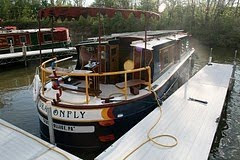 |
Welcome aboard, Clare and Doug!
To see who else has been cruising with
us, check our "Visitors" page. |
We love having boat visitors. This past weekend, our
friends Doug and Clare joined us for a “best of Erie Canal” cruise from the town
of Fairport to Pittsford and back.
We traveled at our usual 4 mph—the historic speed at which mules
pulled Erie Canal boats in 1825. The sun was shining, wildflowers
were blooming, antique bridges arched over us, and ducks dabbled on the canal
banks.
At some point during this idyll, Clare turned to me and smiled. “It’s
lovely living on barge time,” she said.
This time of year, when we’re long past the summer solstice, the sumac leaves are starting to turn red, and the geese are starting to
flock up, I get a little anxious. Fall is coming, and winter after that,
cold and dark.
Clare’s remark pulled me back to the present. Right! I’m
living on barge time—free and easy and relaxed. In the moment, not worrying about the future.
Date Stamp: 1918
 |
| It's a looong way down to the bottom of Lock 32! |
We love making the trip between Fairport and Pittsford as much as we love having boat visitors.
It's a short distance but a big step back in
time, taking you past lots of historical Erie Canal artifacts.
One stop Saturday was Lock 32, a bit more than a
mile outside of Pittsford. This lock opened in 1918 as part of the New
York State Barge Canal—a modernized verion of the Erie Canal, wider
and deeper to accommodate commercial barges.
The canal hasn’t really been modified much since 1918, so locks like this one are basically living museums, with artifacts that are used daily, not
under glass.
 |
| Thanks for the tour, Mr. Lock Tender! |
We climbed to the rooftop viewing platform over the
powerhouse to watch a couple kayaks float through the lock. Then we teetered across
the narrow walkway atop the lock gates to visit with the lock tender on the opposite canal bank.
He invited us into
his office to see the collection of heavy-duty wrenches he uses to adjust lock
machinery. These tools also date to 1918 and were custom-made to fit the equipment at
this lock.
Date Stamp: 1818
We had a floating lunch on the boat, enjoying the bounty of
the Fairport Farmer’s Market. For dinner, we docked in Bushnell’s Basin, midway between Fairport and Pittsford, to eat at
Richardson’s CanalHouse.
 |
| SlowBoat docked between rental boats at Bushnell's Basin. |
This wooden tavern, a mix of Federal and Greek Revival styles and repainted
in period-appropriate mustard yellow, was built in 1818. Travelers considered it
the best inn on the Albany to Buffalo stagecoach line.
After the canal was
completed in 1825, the place started serving canal travelers too. Read about
its colorful history (including a stint as a nudist colony)
here.
We sat on the lawn, with a view of the canal and the boats
passing by. The food was 21st century: spatchcocked chicken, garbanzo burgers, fine wine. But the interior of the restaurant is still pure 1825, a real time-travel experience.
Date Stamp: 1914
 |
| Contemplating the oddball geometry of the Fairport Lift Bridge. |
On Sunday morning, we cruised from Bushnell’s Basin to
Fairport under a light mist.
Both towns have active crew programs and a steady procession
of racing shells passed by: eights, fours, single sculls.
Approaching the city center, you pass under the
Fairport Lift Bridge, a fanciful steel construction of unique design. Each of
the bridge's triangular trusses describes a different angle—no two
are alike.
And one end of the bridge is significantly higher than the other.
This oddball construction has landed the bridge in Ripley’s Believe It or Not.
The other steel-hulled canal boats that routinely ply this stretch of water—
rental boats all—have to ask for the bridge to be lifted before they pass under. They have masts that make them a bit taller than
Dragonfly.
We removed our mast because it throws a shadow on the solar panels! So with our lower profile, we can sneak
under, without a lift—as long as we stick to the high side of the bridge.
“Barge Time” Can Be Slow—or Fast!
 |
| Usually, Barge Time feels like this. |
We cruised on under the bridge, and tied up at the dock, to reluctantly
say goodbye to our guests. The dock master
came scurrying over.
“You almost gave the bridge tender a heart attack!” he exclaimed.
Apparently the bridge tender, who was new on the job, didn't recognize our boat. (The previous guy was used to our tricks.)
"He thought you were one of the rental boats," the dock master said, "and when he saw you coming at the
bridge full speed, he figured you were going to crash!”
We had a bit of a laugh at that. It isn’t every day someone
describes our rate of travel as “full speed!”




















































